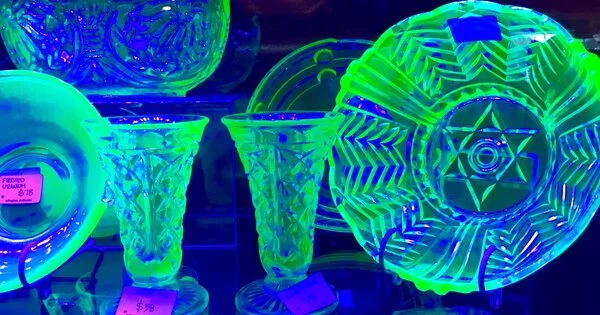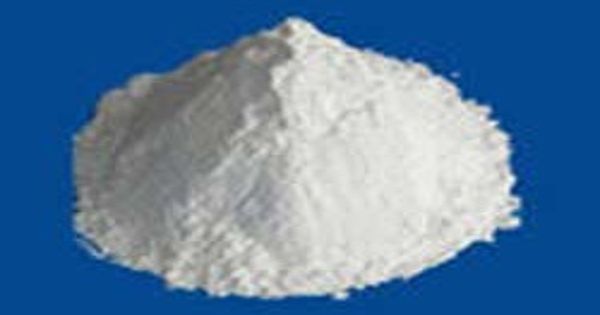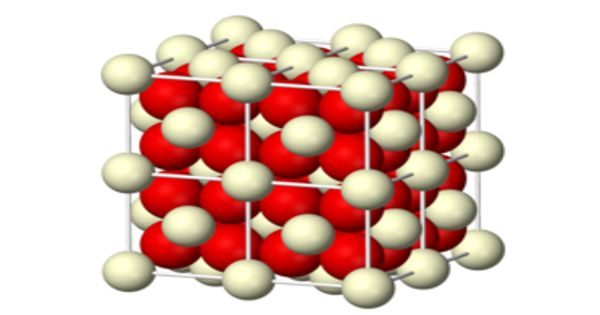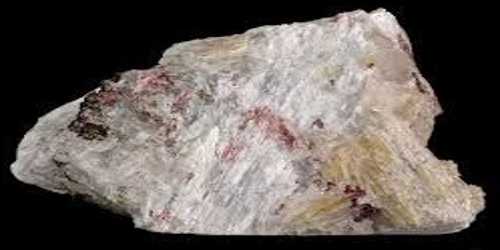Uranium glass is glass that has had uranium, usually in the form of oxide diuranate, added to it before melting for coloration. It is a form of glass that incorporates a small quantity of uranium oxide (typically between 2 and 25%) as a colorant. The amount typically ranges from trace levels to roughly 2% uranium by weight, while some pieces from the twentieth century have up to 25% uranium. Because of the uranium element, the glass has a unique green or yellow-green glow under ultraviolet (UV) or blacklight.
The name “Vaseline glass” refers to its resemblance to Vaseline petroleum jelly. Uranium was first discovered in 1789 by a German chemist and was quickly incorporated to artistic glass for its glowing effect. James Powell’s Whitefriars glass company in London, England, was among the first to commercialize the luminous glass, but other manufacturers quickly saw its commercial potential, and Uranium glass was manufactured across Europe and, eventually, North America.
Uranium glass was previously used to make dinnerware and household items, but it fell out of favor when the availability of uranium to most businesses was severely limited during the Cold War, from the 1940s through the 1990s. Most of these items are now regarded antiques or retro-era collectibles, though art glassware has seen a slight resurrection. Otherwise, modern uranium glass is primarily restricted to small objects such as beads or marbles as a scientific or ornamental novelty.
Here are some key points about uranium glass:
- Historical Background: It became popular in the late 19th century and remained in production until the mid-20th century. It was used to make various glassware items, such as drinking glasses, plates, bowls, vases, and decorative items.
- Fluorescence: The unique characteristic of uranium glass is its ability to fluoresce under UV or black light. When exposed to these light sources, the glass emits a bright green or yellow-green glow, which can be quite striking and beautiful.
- Variety of Colors: While the most common color of uranium glass is green, it can also come in other colors, such as yellow, amber, and even blue. The addition of other minerals and chemicals to the glass mix can produce different hues.
- Radioactive Properties: It is weakly radioactive due to the presence of uranium. However, the level of radioactivity is typically very low and not considered harmful. It’s generally safe to handle and use uranium glass for its intended purposes.
- Collectible: It has become a popular collectible item among antique enthusiasts and glass collectors. People are often drawn to its unique appearance and historical value.
Safety Precautions
While the radioactivity in uranium glass is low and considered safe for most individuals, it is nevertheless prudent to be cautious. Avoid prolonged contact with uranium glass and do not use it to store food or beverages. If you are concerned about specific products, a Geiger counter can be used to monitor radiation levels.
Due to worries about the safety of uranium and the availability of other colorants, uranium glass production fell dramatically in the mid-twentieth century. Uranium glass can now be found mostly at antique and vintage stores, flea markets, and private collections.
In summary, uranium glass, sometimes known as Vaseline glass, is a type of glassware that includes uranium oxide and emits a distinctive fluorescent glow when exposed to UV or black light. While it has historical and collectible significance, it must be handled with caution due to its low-level radioactivity.
















